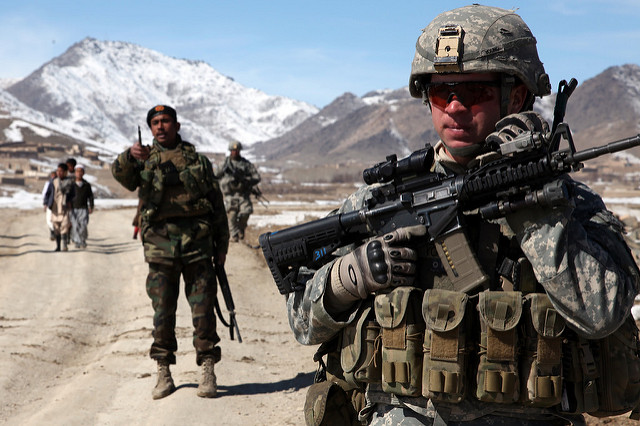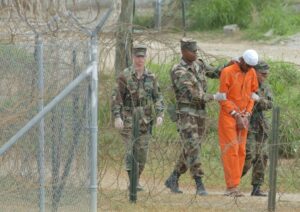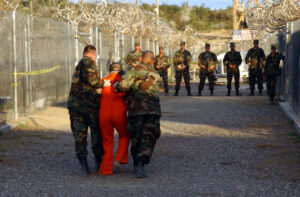Bringing Home the Troops Is Not Enough
Donald Trump has pledged to wind down U.S. engagement in the Middle East. But until we cease our airstrikes, the bloodshed will continue. A U.S. soldier, right, in the Afghan town of Yawez. (DVIDSHUB / Flickr)
A U.S. soldier, right, in the Afghan town of Yawez. (DVIDSHUB / Flickr)
As our nation debates the merits of President Trump’s call for withdrawing U.S. troops from Syria and Afghanistan, absent from the debate is the more pernicious aspect of U.S. military involvement overseas: its air wars. Trump’s announcement and General Mattis’ resignation should unleash a national discussion about U.S. involvement in overseas conflicts, but no evaluation can be meaningful without a clear understanding of the violence that U.S. air wars have unleashed on the rest of the world for the past 17 years.
By our calculations, in this “war on terror,” the U.S. and its allies have dropped a staggering 291,880 bombs and missiles on other countries—and that is just a minimum number of confirmed strikes.
As we contemplate that overwhelming number, let’s keep in mind that these strikes represent lives snuffed out, people maimed for life, families torn apart, homes and infrastructure demolished, taxpayer money squandered and resentment that only engenders more violence.
After the horrific crimes of September 11, 2001, Congress was quick to pass a sweeping Authorization for the Use of Military Force (AUMF). While three presidents have claimed that the 2001 AUMF legally justifies these endless wars as a response to the crimes of 9/11, no serious reading of the Authorization could interpret it that way. What it actually says is:
“That the President is authorized to use all necessary and appropriate force against those nations, organizations, or persons he determines planned, authorized, committed, or aided the terrorist attacks that occurred on September 11, 2001, or harbored such organizations or persons, in order to prevent any future acts of international terrorism against the United States by such nations, organizations or persons.”
As former Nuremberg prosecutor Benjamin Ferencz told NPR a week after 9/11, “It is never a legitimate response to punish people who are not responsible for the wrong done… We must make a distinction between punishing the guilty and punishing others. If you simply retaliate en masse by bombing Afghanistan, let us say, or the Taliban, you will kill many people who don’t believe in what has happened, who don’t approve of what has happened.”
And yet here we are, 17 years later, mired in wars in which we are bombing ever more “nations, organizations (and) persons” who had absolutely nothing to do with the crimes committed on September 11. We don’t have a single real or lasting success we can point to in 17 years of war in 7 countries and “counter-insurgency” operations in a dozen more. Every country the U.S. has attacked or invaded remains trapped in intractable violence and chaos.
Please look at this chart, and take a few moments to reflect on the mass destruction it represents:
Numbers of bombs and missiles dropped on other countries by the U.S. & its allies since 2001
Iraq (& Syria*) Afghanistan Other Countries**
2001 214 17,500
2002 252 6,500 1+ (Y)
2003 29,200
2004 285 86 1 (Pk)
2005 404 176 3 (Pk)
2006 310 2,644 7,002 (Le,Pk)
2007 1,708 5,198 9 (Pk,S)
2008 915 5,215 40 (Pk,S)
2009 119 4,163 5,557 (Pk,Pl,Y)
2010 18 5,100 130 (Pk,Y)
2011 2 5,411 7,789 (Li,Pk,S,Y)
2012 4,083 93 (Pk,S,Y)
2013 2,758 51 (Pk,S,Y)
2014 6,292* 2,365 5,048 (Pk,Pl,S,Y)
2015 28,696* 947 10,978 (Pk,S,Y)
2016 30,743* 1,337 13,625 (Li,Pk,S,Y)
2017 39,577* 4,361 15,179 (Li,Pk,S,Y)
2018 5,075* 5,982 8,738 (Pk,S,Y)
Total 143,810* 73,826 74,244
Grand Total = 291,880
**Other Countries: Lebanon, Libya, Pakistan, Palestine, Somalia, Yemen
These figures are an absolute minimum of confirmed strikes, based on U.S. Airpower Summaries for Afghanistan, Iraq and Syria; the Bureau of Investigative Journalism’s count of confirmed drone strikes in Pakistan, Somalia and Yemen; the Yemen Data Project’s count of Saudi-led airstrikes on Yemen; and other published statistics. Figures for 2018 are through October for Iraq, Syria and Afghanistan; through November for Yemen; and incomplete for other countries.
There are several categories of airstrikes that are not included on this chart, so the real total is certainly much higher. These are:
- Helicopter strikes: Military Times published an article in February 2017 titled, “The U.S. military’s stats on deadly airstrikes are wrong. Thousands have gone unreported.” The largest pool of airstrikes not included in U.S. Airpower Summaries are strikes by attack helicopters. The U.S. Army told the authors its helicopters had conducted 456 otherwise unreported airstrikes in Afghanistan in 2016. The authors explained that the non-reporting of helicopter strikes runs throughout the post-9/11 wars, and they still did not know how many actual missiles were used in those 456 attacks in Afghanistan in 2016.
- AC-130 gunships: The airstrike that destroyed the Doctors Without Borders hospital in Kunduz, Afghanistan, in 2015 was not conducted with bombs or missiles, but by a Lockheed-Boeing AC-130 gunship. These machines of mass destruction, usually flown by U.S. Air Force special operations forces, are designed to circle a target on the ground, pouring howitzer shells and cannon fire into it, often until it is completely destroyed. The U.S. has used AC-130s in Afghanistan, Iraq, Libya, Somalia and Syria.
- Strafing runs: U.S. airpower summaries for 2004-2007 include a note that their tally of “strikes with munitions dropped… does not include 20mm and 30mm cannon or rockets.” But the 30mm cannons on A-10 Warthogs and other ground attack planes are powerful weapons, originally designed to destroy Soviet tanks. They fire up to 65 shells per second and can blanket a large area with deadly and indiscriminate fire, but that does not count as a “weapons release” in U.S. airpower summaries.
- Yemen: Journalist Iona Craig, who has reported from Yemen for many years and manages the Yemen Data Project (YDP), told us she doesn’t know what proportion of actual airstrikes its data represents, and that the number of bombs or missiles recorded in each “air raid” in the YDP’s data is only a minimum confirmed number. Whatever fraction of total air raids YDP’s data represents, the actual number of bombs dropped on Yemen is certainly higher than these figures. YDP just doesn’t know how much higher.
- The U.S. and allies conducting “counter-insurgency” operations in West Africa and other regions.
The U.S. public soon lost its appetite for sending our own sons and daughters to fight and die in all these wars. So, like Nixon with Vietnam, our leaders reverted to bombing, bombing and more bombing, while small deployments of U.S. special operations forces and larger numbers of foreign proxies do most of the real fighting on the ground.
Our enemies call us cowards, especially when we use drones to kill by remote control, but more importantly, we are behaving like arrogant fools. Our country is acting as an aggressor and a bull in a china shop at a critical moment in history when neither we nor the rest of the world can afford such dangerous and destabilizing behavior from a hyper-militarized, aggressive imperial power.
After U.S.-led bombing, artillery and rocket fire destroyed two major cities in 2017, Mosul in Iraq and Raqqa in Syria, the U.S. and its allies conducted fewer airstrikes in 2018, but actually increased the number of strikes in Afghanistan.
We are heading into 2019 with new initiatives to reduce U.S. military involvement overseas. In Yemen, that initiative is the result of massive grassroots pressure on Congress, and is being done in opposition to Trump’s continued support for Saudi aggression in Yemen. In the case of Syria and Afghanistan, it is coming from Trump himself, with broad popular support but bipartisan opposition from Congress and D.C. elites.
Those who are part of the bipartisan war consensus should reflect on the growing public awareness of the murderous futility of U.S. overseas wars. A survey by the Committee for a Responsible Foreign Policy revealed “a national voter population that is largely skeptical of the practicality or benefits of military intervention overseas.” Donald Trump seems to realize this public disdain for endless war, but we shouldn’t let him get away with reducing U.S. troop presence but continuing—and in some cases escalating—the devastating air wars.
A good New Year’s resolution for the United States would be to put an end to the wars we have been engaged in for the past 17 years, and to make sure we do not allow the same military madness that got us into this mess to sucker us into new wars on North Korea, Iran, Venezuela or other countries. Yes, let’s bring the troops home, but let’s also stop the bombing. Sustained advocacy toward the Trump administration and the new Congress by peace-loving Americans will be critical if we are to fulfill this resolution.
This article was produced by Local Peace Economy, a project of the Independent Media Institute.
Your support matters…Independent journalism is under threat and overshadowed by heavily funded mainstream media.
You can help level the playing field. Become a member.
Your tax-deductible contribution keeps us digging beneath the headlines to give you thought-provoking, investigative reporting and analysis that unearths what's really happening- without compromise.
Give today to support our courageous, independent journalists.






You need to be a supporter to comment.
There are currently no responses to this article.
Be the first to respond.